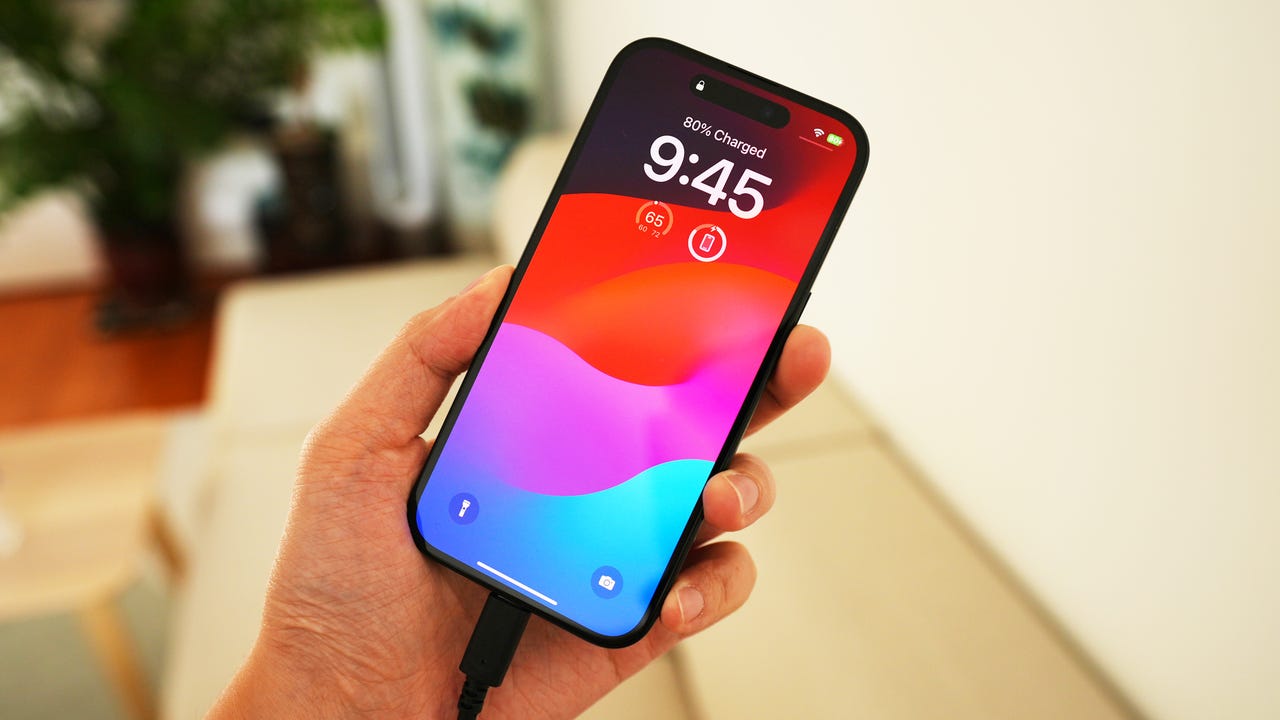
Apple has doubled the lifecycle of the iPhone 15’s battery — not by giving owners a new battery and not with an update, but by updating a support document.
According to Apple, while “iPhone 14 models and earlier are designed to retain 80 percent of their original capacity at 500 complete charge cycles under ideal conditions,” the “iPhone 15 models are designed to retain 80 percent of their original capacity at 1,000 complete charge cycles under ideal conditions.”
Also: How to get your iPhone ready for the landmark iOS 17.4 update
Apple goes on to explain what the term “charge cycles” means. “When you use your iPhone, its battery goes through charge cycles. You complete one charge cycle when you’ve used an amount that represents 100 percent of your battery’s capacity. A complete charge cycle is normalized between 80 percent and 100 percent of original capacity to account for expected diminishing battery capacity over time.”
The company, however, does not explain what “under ideal conditions” means.
So, what’s going on here?
Also: The best iPhone power banks you can buy
First off, I’ve always been curious as to why Apple used the metric that batteries would retain 80 percent of their original capacity after 500 complete charge cycles when a lot of companies claim that their batteries are good for 800 recharge cycles, with Oppo once going as far as claiming that its Find X5 Pro battery could retain 80 percent capacity after 1,600 recharge cycles.
Perhaps Apple was lowballing it with the 500 figure so it could underpromise and overdeliver. In my experience, I’ve seen batteries that were worn after fewer than 500 recharge cycles, and others lasting well beyond 800 recharge cycles. It depends on a lot of things, one of the biggest factors being if the battery has been subjected to high temperatures.
However, there might be another explanation for Apple’s approach, specifically a tweak that Apple pushed into iOS 17 exclusively for the iPhone 15.
Also: How to capture spatial video with the iPhone 15 Pro (there’s a trick)
Apple offered three different charging optimization settings for the iPhone 15: Optimized Battery Charging, 80% Limit, and None.
Optimized Battery Charging aims to reduce battery wear by delaying charging beyond 80% in certain situations (such as when charging at night), while 80% Limit sets a hard limit (although occasionally the battery will be charged to 100% to maintain accurate battery charge estimates).
Has Apple improved the optimization algorithms to make it more effective at reducing battery wear, or do the “under ideal conditions” include making use of the 80% Limit?
Has Apple changed the battery in some way to improve the recharge cycle lifespan? After all, Apple does say that the iPhone 15’s battery was “designed” to retain 80 percent of its original capacity at 1,000 complete charge cycles.
Also: iPhone 15 models compared: iPhone 15 vs. Plus vs. Pro vs. Pro Max
But why leave updating the support document until now?
Maybe this is because Apple is getting ready to roll out a change in iOS 17.4 to iPhone 15 phones that now show recharge cycles.
iOS 17.4 will show recharge cycles — called Cycle Count — for iPhone 15 users. Brandon Butch/X
Previously, if you wanted to know how many recharge cycles your battery had been through, you needed a separate app running on a Mac, or to go through a convoluted process to extract the data.
Also: The best iPhone 15 screen protectors
Whatever the reason, we will have to wait and see what sort of battery lifespan real-world use uncovers. Hopefully, users see this dramatic increase, because it’s much needed. My 17-month-old iPhone 14 Pro Max is on 438 recharge cycles of its rated 500!
My iPhone 14 Pro Max is close to its 500 recharge cycles in less than 18 months. Adrian Kingsley-Hughes/ZDNET
Featured reviews




















